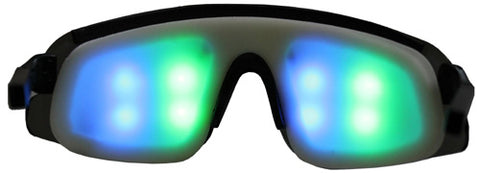It’s commonly reported and believed that using devices with blue lights at bedtime is unhealthy for our sleep hygiene. As a result, at Mind Alive, we are often asked why we recommend using blue or a blue/green blend on our multicolor eyeset to help improve sleep. Despite buying into the blue/melatonin/insomnia connection, our clients constantly reported that they had their worst sleep using red light and their best sleep using blue or a blue/green blend. We decided to look a little deeper into this reporting.
When the sun is shining near noon, all of the wavelengths of the visible spectrum make it through the atmosphere. But because water vapor in our sky blocks the red end of the spectrum, we see an emphasis of blue.
Figure 1. Typical solar spectra near noon.

Ref: Why light spectrum matters for circadian alignment? – OSIN Lighting
As an evolutionary process, our eyes have developed special receptors sensitive to the blue part of the visible spectrum that is abundant during the day and stabilizes our circadian rhythms. Figure 1 shows the relative spectral components as seen on Earth. But when it comes to blue light and sleep, there are special receptors that respond to the wavelength at 460 nm and project their signals into the pineal gland. So, when we are outside in sunlight, the blue-tinted sunlight (notice our blue sky?) stimulates the pineal gland to suppress melatonin, which in turn tells our brain and body that it’s daytime and time to wake up, leaving us feeling energetic and mentally sharp (Figure 2). Exposure to morning sunlight also helps raise cortisol and body temperature plus numerous brain activities including those necessary for good mood and socialization.
Most cells in the body utilize a cyclic pattern when working optimally. So potentially, just about any area of the body can falter without adequate sun stimulation. Falling out of step with our natural circadian rhythms is tied to increasing risk of disease, including cancer, diabetes, and heart disease.
Figure 2. How blue light signals travel to the pineal gland.

Ref: The inner clock—Blue light sets the human rhythm - Wahl - 2019 - Journal of Biophotonics - Wiley Online Library
However, it is a new, common belief that blue light at bedtime suppresses melatonin, through the same mechanisms that wake us up in the morning. This in turn, impairs sleep and leads to a variety of both mental health and physical health problems.
White LEDs are actually blue LEDs that shine through a layer of phosphorus, which converts the blue light to “white” light. Standard household and office fluorescent lights also use a phosphorus film coating on the glass tube to convert the blue light to white light. It has been a technical challenge in developing a phosphorus coating that can block much of the blue light and therefore a large amount of blue gets through.
Figure 3 shows mildly blue-filtered sunlight in comparison to a relative representation of typical white LED light coming from an LCD TV, computer, tablet, iPad, smartphone, etc. Notice that although there is an emphasis of blue with an LED, there is also a broad spectrum of wavelengths (colors) being represented. It is our stance that there must be a fair degree of white-light present for melatonin suppression to take place.
Figure 3. Normalized sunlight exposure in relation to LED white light.

Ref: Why do we block blue light? - A simplified explanation – GembaRed
Proponents of the dangers of blue-light claim the sunset is red-shifted and blue is quite absent and that makes for proof that we have evolved in going to sleep with a red-shifted solar spectrum. However, such is not the case. In actual fact, most animals don’t go to sleep until some time following the sunset. Pre-technology humans that lived only in natural light often went to sleep after the sunset was long gone. As the Earth rolls away from the sun, there is roughly 30-60 minutes of deep blue sky that soothes us prior to falling asleep. This blue-weighted light has never caused animals or humans issues with falling asleep. So, it’s probable that it’s not this pure blue light that interferes with melatonin production and sleep. But it might be blue-shifted white light that interferes with sleep.
There is also the issue of mental activation while staring into an electronic screen. Studies into circadian rhythms and light have failed to address this part of the equation.
Typically, when people use their devices at night, they are also cognitive during usage. So, a study by Rångtell et al., 2016* was completed to test this hypothesis. The study followed these simple criteria:
- All participants had to get outside during the day to get their daily sunlight and circadian rhythm reset.
- All participants read a fictional novel before bedtime. Half of the participants read it on a tablet and half from a book.
- After one week, the participants switched their tablets and books with each other.
Conclusion:
No differences in sleep patterns or melatonin levels were found between the two groups.
Summary:
Many people never develop circadian problems using tablets or TV before bedtime. This study concluded that as long as one gets outside during the day, there are no effects from tablets on circadian rhythms.
Our multi-colored eyesets use RGB LEDs. After 20 years of color light experimentation, we continue to find that blue is the best color for inducing sleep while using entrainment.
*Frida H. Rångtell, Emelie Ekstrand, Linnea Rapp, Anna Lagermalm, Lisanne Liethof, Marcela Olaya Búcaro, David Lingfors, Jan-Erik Broman, Helgi B. Schiöth. (2016). Two hours of evening reading on a self-luminous tablet vs. reading a physical book does not alter sleep after daytime bright light exposure. Sleep Medicine, 2016 Jul;23:111-118.
https://pubmed.ncbi.nlm.nih.gov/27539026/#:~:text=Results%3A%20There%20were%20no%20differences,light%20stimulus%20on%20melatonin%20secretion
